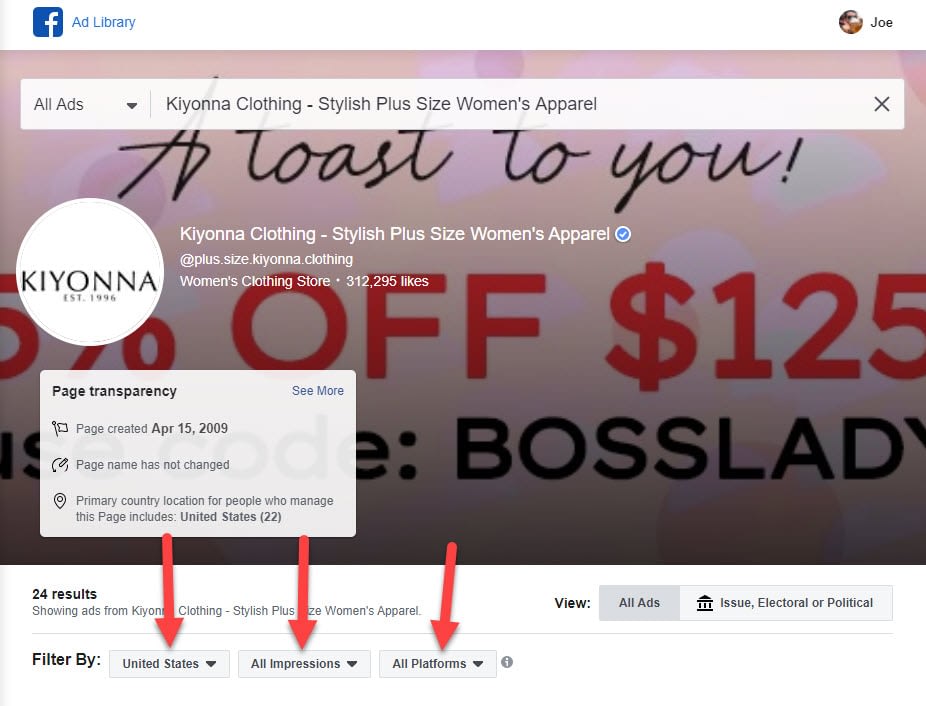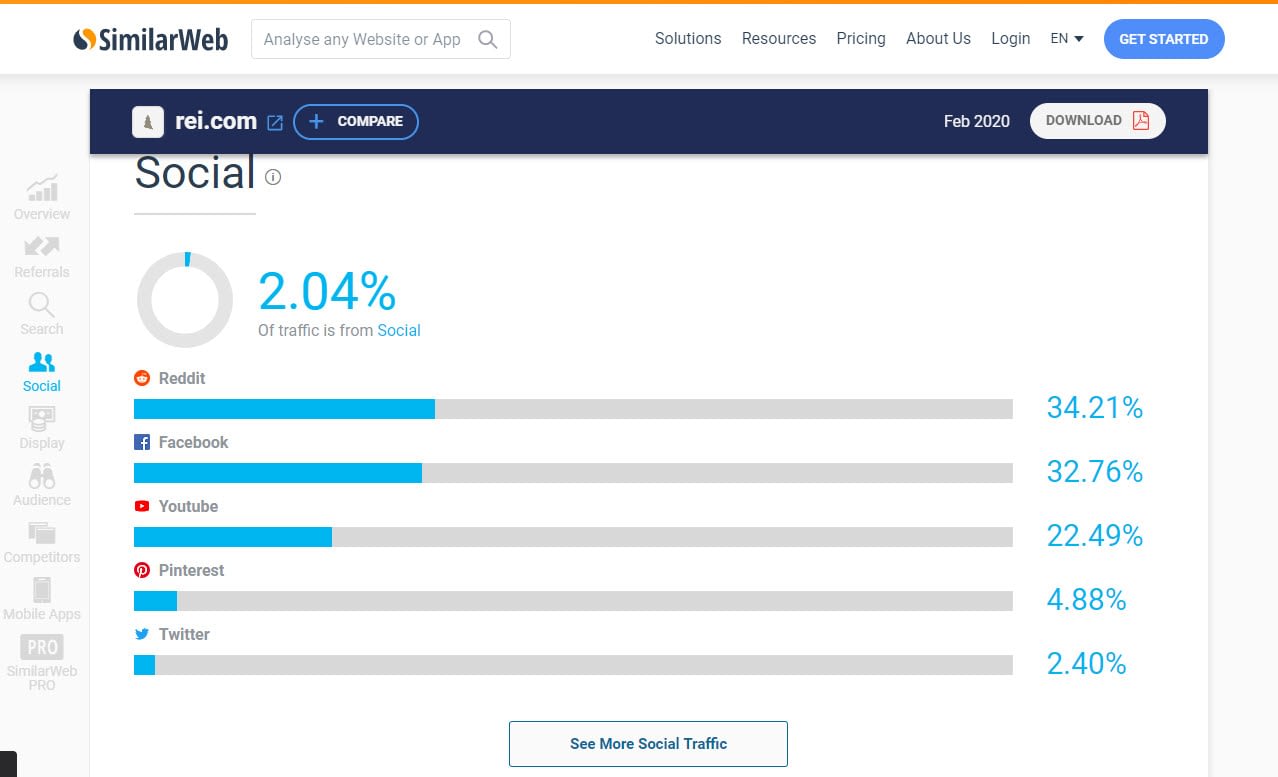Real estate agents do it. Ecommerce stores do it. Bloggers do it. Facebook advertising has its pros and cons, but when done right, Facebook ads send valuable, targeted business to your website. What’s the quickest way to approach ads properly? Start by researching your Facebook Ads competition.
This means exploring how other brands in your industry utilize Facebook Ads to improve business and gain followers.
You don’t have to copy the competition, but this gives you a quality look into the type of content that gets noticed. Not only that, but you’re able to eliminate ineffective post types from your social plan.
The benefits of researching your Facebook Ads competition
Why can’t you just go with your heart and develop content that’s related to your brand?
The problem is that social media planning and development, just like anything, takes time. Sometimes you have to spend a decent amount of money, and there’s nothing worse than creating a beautiful video, photo, or infographic only to find that no one cares for it.
So, read below to understand exactly why researching your Facebook Ads competition is so beneficial.
- There are excellent tools to locate brands just like yours.
- You’ll get ideas for Facebook ads that you never would have thought about before.
- You’ll stumble upon the failed ads that you should avoid, ultimately saving your time and money before committing to similar campaigns.
- This is a way to mimic full social campaigns, not just one ad.
- Discover what types of traffic come in from their ads.
- You get to find out what links are being used and what their redirect pages look like. For instance, you can take pointers on landing pages.
- This serves as a measurement tool prior to investing in your own ads. Facebook quantifies everything.
How to look into your Facebook Ads competition for inspiration
Not all Facebook research is efficient, so it’s essential to figure out the best option for your brand. For instance, you may discover that some of the competitors you follow aren’t that great at creating Facebook Ads. Therefore, our first strategy below won’t be all that effective if that’s the case.
Having said that, we’ll cover a handful of options for spying on your competition for you to decide on the best content for your ads.
Start by looking at the Business Pages of your competition
This is the simplest of research strategies, but it may end up being tedious and time-consuming depending on your situation and industry.
However, don’t underestimate the power of going straight to Facebook Business Pages.
The process uses the Facebook Ad Library, as listed in the point below. Yet, with this method, we’re targeting a particular business from the start.
Here’s how:
Go to a competitor’s Facebook Business page. For this example, I’m going to Dollar Shave Club’s page.


Ads posted by your competitor aren’t shown directly in the regular Facebook Business page feed. Therefore, you have to find the Page Transparency module.
Click on the See More link.


This reveals a popup window.
Go down to the area called Ads From This Page. Click on the Go To Ad Library link.


Now we can see all of the past and active ads running from one company, as seen below:


Dollar Shave Club is a wonderful example of how Facebook Ads are supposed to be developed and managed.
You can immediately see that Dollar Shave Club has hundreds of ads running at the same time – something that many small businesses don’t do.
However, spending less money on each hyper-targeted ad is a far more effective approach than piling most of your cash into one ad that targets a larger group of people.
This is one example of what you might learn from your Facebook ads competition!
Other than that, it’s best to view more information about each ad. Click on the See Ad Details for this.


All ads are different, but three elements stand out in this one:
- Dollar Shave Club actually has five versions of this ad, with minor tweaks to each one. This could help with targeting and finding the right wording. Facebook dynamically delivers different ads based on the situation.
- The call-to-action link goes to a highly-optimized landing page about the product being highlighted.
- The vast majority of Dollar Shave Club ads are short videos.


Use the goldmine that is the Facebook Ad Library
The point above already brings you to the Facebook Ad Library, but that process is more for honing in on one company, then checking on the ads currently running.
However, a full library is provided for you to examine entire industries, with filters for finding the perfect comparisons for your company.
Begin the search by going to the Facebook Ads Library.


A search bar is available for you to type in any keyword. Consider keywords that relate to your industry, like competitor names, or things like “real estate” or “adventure outfitters.”
The main search bar is for all ads, but you also have the option to only look for political or housing ads. The reason these are separated is because there are extremely specialized rules for politics and real estate.
Most businesses will start with the All Ads search. So, let’s pretend I run an online store for plus size clothing. When I type in “plus size clothing,” brands that relate to that keyword appear as suggestions.


Click on the More Results By Page link to see even more options that relate to your keyword. If these companies don’t seem like actual competitors, try an alternative keyword until you find some.


After you select a company to research, Facebook uncovers all ads from that business page.
Use the filters to focus on ads that have been posted over the past few days. Some of the other filters are great for showing ads based on platform and country.


For example, you can filter to see ads that are only showing on Instagram or Facebook Messenger.
The library is also nice because it tells you which platforms all of the ads are currently running on. This brand utilizes all of the options: Facebook, Instagram, Audience Network, and Messenger.


Overall, the Facebook Ad Library doesn’t provide any analytical information.
However, you can still see which types of companies are running lots of ads. Does this mean they are effective? No. But they at least have experience.
Not only that, but viewing the ad details is an excellent way to find content ideas for your ads.
Case in point, the Kiyonna Clothing company has an impressive collection of ads going simultaneously.
I picked a random ad and found that it’s a slideshow gallery of clothing for brides, like engagement party dresses.


Another ad has a 15-second video to showcase a Valentine’s Day Special. Sure enough, the “$50 Off A $150” purchase text is highlighted, with nothing else cluttering that message.


Looking into other industries shows how different advertising methods are used for other customers.
Many of the adventure outfitting companies I examined have playful videos of people being active outside.


I searched for real estate agents in Illinois and found that open houses are often advertised on Facebook. This makes a lot of sense, since Facebook lets you target users in that area who are currently looking for homes.


Ask Facebook why you see certain ads on your feed
Another way to understand how competitors target their ads is to ask Facebook why you’re being targeted in the first place.
To do this, scroll through your personal Facebook feed to find any ads. A quick way to get competitor ads in your feed is to follow their pages.
Once you locate an ad that’s from your competitor – or from a company that’s like your competitors – click on the “…” button in the upper right-hand corner of the ad.


A menu appears. Click on the item that reads “Why Am I Seeing This Ad?”


This gives you a wonderful look into how some of your competitors are targeting their customers. Sometimes it doesn’t reveal much information, but other times it’s a good start for how you should approach users on Facebook.
The previous ad targeted writers, so that makes sense for me. Under that additional information panel I can see that the ad focuses on people who have shown interest in Freelance Writing Jobs.
You’ll also find details on age ranges, locations, and languages.


The following is another ad that showed up on my feed. It’s for a car-sharing company. I’ve done quite a bit of travel, so that’s probably why it showed up on my feed.
This one is a bit different, seeing as how it doesn’t show the ad to people over 45. So, if you were in this industry, it may show you that other companies have decided that people over 45 have minimal interest in sharing their cars.


Consider third-party tools to analyze ad traffic sources and campaign effectiveness
The tips mentioned above are great for establishing what types of content are used by your competition.
But do you have any idea if this content is actually effective? Unfortunately, not directly through Facebook.
The only way to see results is to scan through your personal Facebook Feed, since those sponsored posts have likes and comments for everyone to view.
So, how do you evaluate ad campaigns from competitors?
A third-party social analytics tool is required.
Here are some options to consider:
As an example, Buzzsumo provides several tools for checking on competitors, such as the Facebook Analyzer. This is great for benchmarking against other companies. It also pairs with the content checker for seeing where social shares are coming from and how many are occurring.


Ahrefs has similar features for researching your competitors and monitoring a particular niche. It also explores keywords, content, and your own site to figure out what you’re doing wrong and how you can compete with what other companies share on Facebook.
SpyFu is even more relevant for researching about ads, since it cracks into several unique areas that your competitors are doing well with.
There’s a spot to paste in your competitor’s URL. It then presents all of the brand’s ads on social media and Google. Information like clicks and cost are shown, with keyword suggestions for these advertisements as well.


SimilarWeb is one of our favorites for tapping into areas like search data and social referrals.
As seen in the screenshot, SimilarWeb displays where REI gets most of its social traffic. It turns out that only about 2% of its website traffic comes from social media.
However, Reddit is the top traffic source! Facebook is also high up there, but I never would have assumed that people are finding information about REI on Reddit.


There are plenty of other features for you to consider for all of these tools. Some of them (SimilarWeb in particular) have free features for you to play around with. After that, you may end up paying. For instance, Ahrefs is a very expensive product that smaller companies should most likely stray away from.
Overall, Facebook collects quite a bit of data on users. That’s why companies have such an easy time with targeting. However, it takes some research on your end to maximize the efficiency of your own Facebook Ads campaigns.
Now it’s time to implement what you’ve learned from your Facebook Ads competition
From spying on your competitors through their own Facebook pages to integrating with more advanced social analytics tools, there are plenty of options for you to learn about your Facebook Ads competition.
Use the data and observational information as your content guide.
Heck, you may discover that one or two companies are perfect examples of how you should be approaching Facebook Ads. You could potentially devise your entire content strategy off of one similar company.
The post How to Research Your Facebook Ads Competition to Improve Your Advertising Campaigns appeared first on Revive Social.